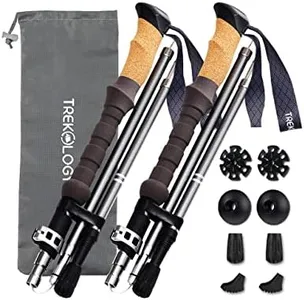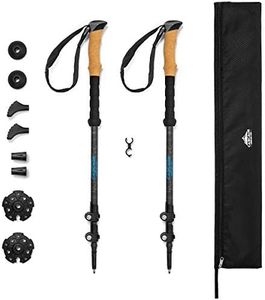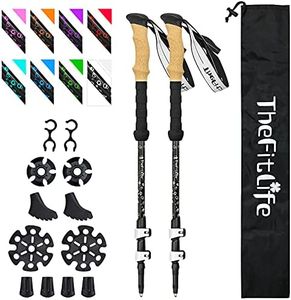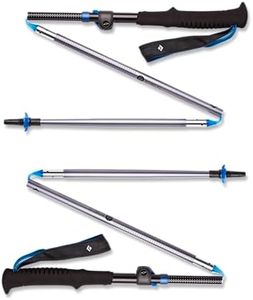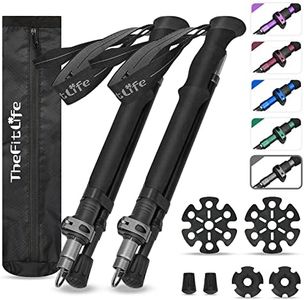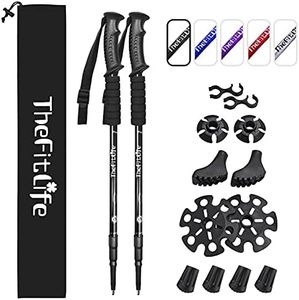We Use CookiesWe use cookies to enhance the security, performance,
functionality and for analytical and promotional activities. By continuing to browse this site you
are agreeing to our privacy policy
10 Best Lightest Trekking Pole
From leading brands and best sellers available on the web.Buying Guide for the Best Lightest Trekking Pole
Choosing the best trekking pole, especially when prioritizing weight, is all about balancing comfort, durability, and functionality. Lightweight trekking poles can make a big difference, especially on long treks or when you want to reduce the strain on your arms and shoulders. However, weight is just one factor; consider how that pole feels in your hand, how easy it is to pack and adjust, and whether it suits the type of terrain you'll encounter. Think through where you'll be hiking, how much stability you need, and how easy you find handling trekking gear.WeightThe weight of a trekking pole refers to how heavy it feels in your hand or backpack. This is a key factor because lighter poles reduce fatigue and are easier to swing with each step, making them ideal for long-distance hikers or those with joint concerns. Trekking poles typically range from very lightweight (under 200 grams per pole) to heavier options (350 grams or more per pole). Very lightweight poles are great for fast hikers and those covering big distances, while sturdier, slightly heavier ones may be better for rough hikes where you need more support. Think about your hiking style: if you cover a lot of ground or want to move fast, go as light as possible, but if you prioritize stability over long days, a little extra weight might be worth it.
MaterialTrekking poles are usually made from aluminum or carbon fiber. Material matters because it affects both the overall weight and the pole's durability. Carbon fiber poles are usually the lightest, making them popular for those looking to cut every possible ounce, but they can be more expensive and a bit more fragile when it comes to side impacts. Aluminum poles are tougher and less likely to snap but do weigh a bit more. If saving weight is your top priority, look for carbon fiber; if you hike in rocky or challenging terrain and want something less likely to break, aluminum could be better.
AdjustabilityAdjustability refers to whether and how you can change the length of your trekking poles. Fixed-length poles are often the absolute lightest, but they don't let you change length for different terrain or for sharing with others. Adjustable poles can be shortened for steep climbs and lengthened for descents, which makes them more versatile. Most adjustable poles use locking mechanisms that add a bit of weight, but the flexibility can be worth it for varying trail conditions. If your hikes involve flat terrain and you always want the lightest option, fixed might be best; adjustability is better for changing trails and shared use.
Packed SizePacked size describes how small the trekking poles become when folded or collapsed. This is particularly important if you plan to stow them in your bag or attach them to your backpack when not in use. Poles that break down into shorter segments are easier to carry and transport, especially for travel or multi-sport adventures. If space is a premium or you want to put the poles inside your bag for air travel or packing, look for those with short packed lengths; for everyday use where you’ll seldom pack them away, this may be less important.
Grip MaterialThe grip material refers to the type of material used for the handle of the trekking pole. Common grip materials include cork, foam, and rubber. Cork grips mold to your hands over time, reduce vibration, and are good in hot conditions because they handle sweat well. Foam grips are lightweight and comfortable, but may soak up sweat more. Rubber grips provide good insulation in cold weather but may become slippery in hot, sweaty conditions. Consider where and how often you'll use your poles: cork for general comfort and versatility, foam for lightweight use, and rubber for cold, wet, or budget-focused needs.
Locking MechanismThe locking mechanism is what keeps adjustable trekking poles at the length you set. There are a few main types: external lever locks, twist locks, and push-button locks. External lever locks are generally considered the easiest and most reliable, even with gloves on or in wet conditions, but they may add a slight amount of weight. Twist locks are lighter but can sometimes slip under pressure. Push-button locks are often found on folding models and are quick to use. If you want something super-simple and reliable, external lever locks are popular, but if you prioritize weight, look at twist or push-button options.
